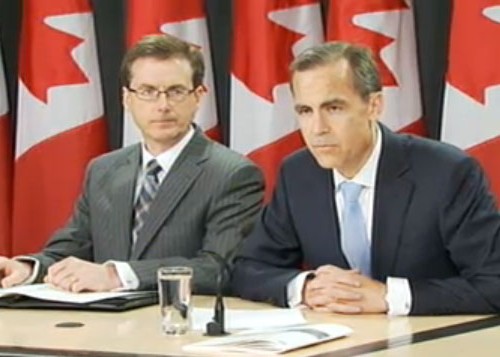Release of the Monetary Policy Report
Available as:
PDF
Good morning. Tiff and I are pleased to be here with you today to discuss the April Monetary Policy Report, which the Bank published this morning.
- As anticipated in January, the global economic recovery is becoming more firmly entrenched and is expected to continue at a steady pace.
- In the United States, growth is solidifying, although consolidation of household and, ultimately, government balance sheets will limit the pace of the expansion.
- European growth has strengthened, despite ongoing sovereign debt and banking challenges in the periphery. The disasters that struck Japan in March will severely affect its economic activity in the first half of this year. The resulting disruptions to global supply chains are projected to reduce the growth in the Canadian economy in this quarter by about half of a percentage point, with that lost activity likely to be recovered in subsequent quarters.
- Robust demand from emerging-market economies is driving the underlying strength in commodity prices, which is being further reinforced by supply shocks arising from recent geopolitical events. These price increases, combined with persistent excess demand conditions in major EMEs, are contributing to broader global inflationary pressures. Despite the significant challenges that weigh on the global outlook, financial conditions remain very stimulative and investors have become noticeably less risk averse.
- In Canada, recent economic activity has been stronger than anticipated, although the profile is largely consistent with the underlying dynamics outlined in January. Aggregate demand is rebalancing toward business investment and net exports, and away from government and household expenditures.
- As in January, the Bank expects business investment to continue to rise rapidly and the growth of consumer spending to evolve broadly in line with that of personal disposable income, although higher terms of trade and wealth are likely to support a slightly stronger profile for household expenditures than previously projected.
- In contrast, the improvement in net exports is expected to be further restrained by ongoing competitiveness challenges, including headwinds from the persistent strength in the Canadian dollar.
- Overall, the Bank projects that the economy will expand by 2.9 per cent in 2011 and 2.6 per cent in 2012. Growth in 2013 is expected to equal that of potential output, at 2.1 per cent. The Bank expects that the economy will return to capacity in the middle of 2012, two quarters earlier than had been projected in January.
- While underlying inflation is subdued, a number of temporary factors will boost total CPI inflation to around 3 per cent in the second quarter of 2011 before total CPI inflation converges to the 2 per cent target by the middle of 2012. This short-term volatility reflects the impact of recent sharp increases in energy prices and the ongoing boost from changes in provincial indirect taxes.
- Core inflation has fallen further in recent months, in part due to temporary factors. It is expected to rise gradually to 2 per cent by the middle of 2012 as excess supply in the economy is slowly absorbed, labour compensation growth stays modest, productivity recovers, and inflation expectations remain well-anchored.
- The persistent strength of the Canadian dollar could create even greater headwinds for the Canadian economy, putting additional downward pressure on inflation through weaker-than-expected net exports and larger declines in import prices.
- An additional downside risk to inflation in Canada relates to household spending, which could be weaker than projected, given high household debt levels. On the upside, commodity prices and global inflation could rise faster than anticipated and there could be stronger-than-expected momentum in household expenditures.
- Overall, the Bank judges the risks to the Canadian inflation outlook are roughly balanced over the projection horizon.
- Reflecting all of these factors, the Bank decided yesterday to maintain the target for the overnight rate at 1 per cent. This leaves considerable monetary stimulus in place, consistent with achieving the 2 per cent inflation target in an environment of material excess supply in Canada. Any further reduction in monetary policy stimulus would need to be carefully considered.
With that, Tiff and I would be pleased to take your questions.


